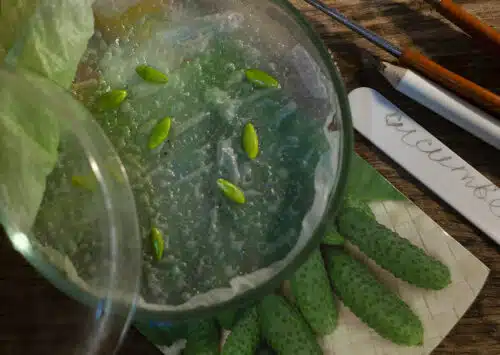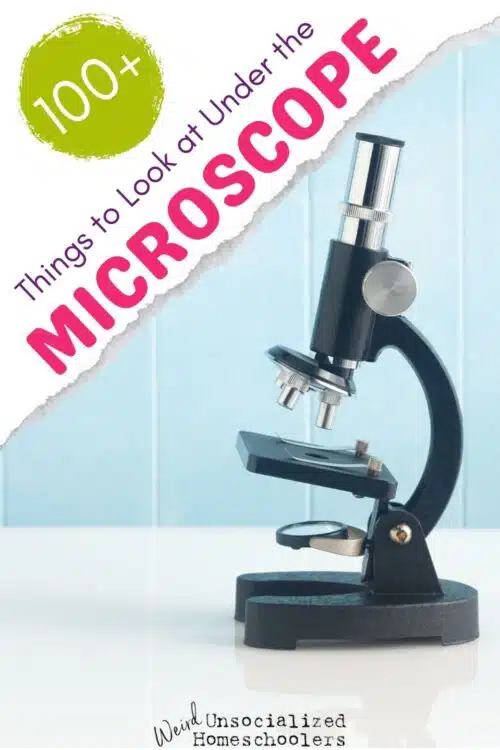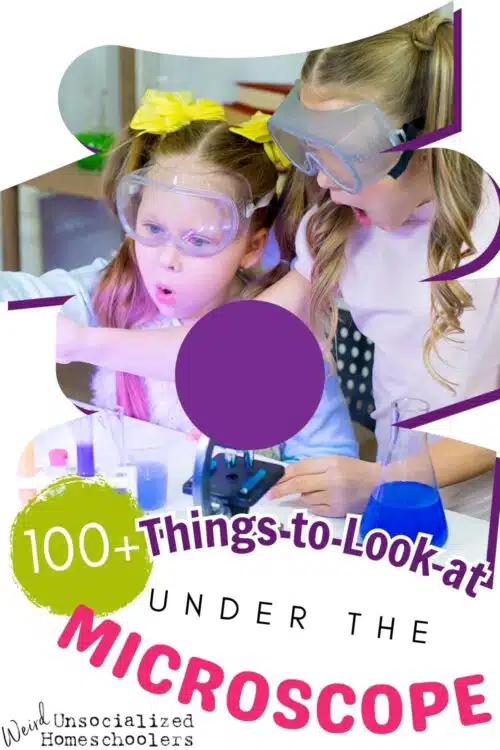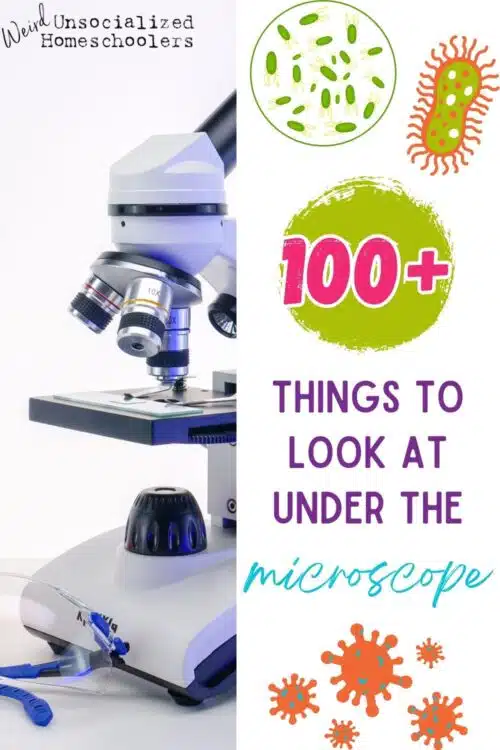100+ Free Things to Look at Under the Microscope (That You Already Have at Home)
100+ Things to Look at Under the Microscope (with FREE Printable Checklist)
If you need to get your kids interested in using a microscope, this list of 100+ things to look at under the microscope is full of stuff you probably already have at home or can easily get your hands on!
Be sure to download your printable checklist of these 100+ suggestions too. You’ll find the link toward the bottom of this article. The printable checklist even includes plenty of extra spaces for you to write in your own ideas for things to look at.

Who needs to make science a little more fun? {Raises hand} This bucket list of over 100 things to look at under the microscope will help!
Do you own a microscope? I invested in one years ago when my oldest took high school biology. It’s spent more time in the box than out, but I’m remedying that! Why? Because I’m looking for ways to make science exciting around here, y’all.
Whenever I decide to get it out, dust it off, and set it up, no one can resist the urge to sneak a peek! (Hooray!) Even my most “blah, everything related to school is boring” kids love looking at things under the microscope.
Even if your kids are young, learning the ins and outs of using a microscope is a useful skill. Coolness factor and taking care of one of the pricier homeschooling tools aside, most kids will take biology or higher-level science courses in high school. If your kids attend a co-op or take a dual-enrollment course, in-person labs can be intimidating when there are a bunch of other students breathing down your neck for their turn at the lens. It’s essential – and a lot more comfortable – to get familiar with using the microscope at home.
To help make these practice labs a little more engaging (and hopefully memorable), I created a microscope bucket list of sorts. (Scroll to the bottom for a free printable version.) No need to purchase prepared slide sets (though those are fun!). Everything is cooler under a microscope!
Sometimes, it’s easy to overlook the simple specimens all around you. That’s what this list is for – to give you some ideas and spark your own imagination.
Full disclaimer: some of this list is gross. I’m sorry. We’ve already established I’m weird, so you’re reading at your own risk.
Things to Look at Under the Microscope from Outside
First, off, get outside for some fresh air and specimen-collecting fun. Take a nature walk, visit the local park, or just get out in your own backyard.
Outdoor/Nature
- Blade of grass
- Pond water
- Pool water
- Water from a mud puddle
- Soil (Compare different types of soils like organic, soil made for planting vegetables or soil with additives and chemicals.)
- Beach sand (The Homeschool Scientist has a great article on comparing beach sand from different locations.)
- Pine cones (Break off a single scale.)
- Dirt (Gather samples from various locations to compare)
- Mushroom
- Fungus growing on a rotting log
- Dirt from around an ant hill (Just be careful! If they’re fire ants, let them keep their dirt.)
In our neighborhood, some people use well water, and others have city water. If you have a similar situation where you live, it would be interesting to take samples of things like dirt and grass from each type of yard and compare the differences. Ask permission first! People get a little weirded out seeing someone digging around in their yard.
Do you think you’d see anything different in the soil or grass in your neighbor’s yard compared to yours? There’s only one way to find out!
Parts of a Flower
- Petals
- Stamen
- Leaves
- Roots
- Seeds
- Stem
You may need to brush up on all the parts of a flower so you don’t miss anything cool and can dig a little deeper with your older students. There’s also a great dandelion life cycle unit study your younger students might enjoy.
You might also want to compare the leaves or flowers of your house plants or keep that in mind as a rainy-day alternative.
Backyard
- Feathers
- Leaves
- Tree bark
- Dead bugs
We live in Florida, so I can walk out my front door, and it’s a guarantee I’ll find a dead bug of some kind on the front doorstep. After a hurricane not long ago, there was a giant dragonfly out there who didn’t make it through the storm. I scooped him up in the name of science.
Here are a few more ideas of things to look at under the microscope (if you’re lucky enough to find them):
- Butterfly wings
- Bee’s wings (Here’s a printable bee activity for younger students)
- Dragonfly wings
- Exoskeleton of cicada
- Shed snake skin
- Pine needle
- Ant
Don’t just glance at that ant! Check out all the cool body parts. Younger kids might enjoy digging deeper by completing an ant interactive notebook.
Body Parts of an Ant
- Head
- Petiole
- Exoskeleton
- Thorax
- Mandibles
- Abdomen
- Hair (Yes! Ants have hair!)
- Eyes
Things to Look at Under the Microscope from Around Your House
Sometimes we homeschoolers joke about the “science experiment” we left in the back of the fridge – you know, those moldy leftovers we forgot about. But, there really is a whole wealth of science material in your kitchen. Check out these ideas for things to look at under the microscope from around the house.
Food/Pantry Items
- Moldy bread
- Fresh bread (Compare the two!)
- Apple skin
- Bananas
- Onions
- Peppers
- Garlic
- Cucumber seeds
- Celery leaves
- Carrot tops
- Yeast
- Sugar
- Salt (Another fun opportunity to compare since they look so similar to the naked eye.)
- Lemon peel
- Poppyseed
- Flour
- Cocoa powder
- Baking soda
- Baking powder
- Blue cheese
- Milk
- Potato skin
- Hot sauce
- Raw egg membrane
- Raw yolk
- The weird white squiggly thing in raw eggs (Google it and learn something).
If your kitchen isn’t gross enough, head to the bathroom!
More Gross Stuff
- Skin
- Saliva
- Ear wax
- Booger
- Blood
- Used bathwater
- Hair from your brush
- Fingernail
- Soap scum
- Mold
- Mildew
- Lime
- Calcium
- Rust
- Cheek swab
What does a human skin cell look like under the microscope? Can you locate any of these parts of the cell? Take a swab from each family member and compare them.
Sketch what you see under the microscope and note what cell parts you recognize. (Note: Depending on your microscope and how powerful it is, you may or may not be able to see individual parts of a cell.)
Parts of a Cell
- Cell membrane
- Cytoplasm
- Ribosomes
- Nucleus
- Smooth endoplasmic reticulum
- Lysosome
- Chloroplast
- Cell wall
- Vacuole
- Golgi bodies
- Nucleolus
- Mitochondrion
- Rough endoplasmic reticulum
Pet Stuff
- Nail clippings
- Fur
- Whiskers
- Scales
- Vacuum cleaner gunk
Do you have a bagless vacuum cleaner? I do. I empty our vacuum every time I use it, and it is disgusting!
We have two cats, one dog, and four people, and whatever ends up in my vacuum container each day is enough to make me want to puke no matter how many times I do it.
I know. I have issues.
- Cat litter
- Stool samples
Listen, I’m putting it on the list. It’s just an idea! I know it’s disgusting, but isn’t that the point?
Maybe one of your kids will get up and get excited about science because there’s dog poop on this list! Who knows? Don’t judge me! You know you were at co-op last week standing over a pile of owl pellets. That you PAID for. So, there’s that.
I recommended purchasing goggles and gloves – especially if you’re going to explore some of the nasty stuff on the list. (Be sure to pay attention to the glove sizes. Some come in kids’ sizes and others are adults’ sizes. Also, some are latex and some aren’t. If someone in your family has a latex allergy, you’ll want to double-check that your gloves are latex-free.)
Create Disgusting Petri Dish Experiments
Gather swabs from all over your house. Create a disgusting petri dish lab and see just how gross your home is. Try not to cringe.

Take swabs from the:
- Fridge (shelves, door, produce bin)
- Bedroom
- Closet floor
- Treadmill or workout area
- Bathroom counter
- Sink handles
- Bottom of the toilet
- Toilet handle
- Old dish sponge
- Pillows
- Toothbrush holder
- Soapdish
- Dishwasher
- Oven
- Backseat – or floorboards – of your car
- Pet food and water bowls
- Dining room table
- Microwave
- Coffee pot
- Dirty sneakers
- Kitchen sink (“They” say it’s the dirtiest spot in your house.)
Download and print your own copy of our checklist of 100+ Things to Look at Under the Microscope! (Includes extra pages to write your own suggestions.)
Download your own copy of these 100+ Things to Look at Under the Microscope, print it, and check things off as you go! The printable version includes an extra 1 1/2 pages (75 lines) for writing in your own ideas too.
What weird stuff would you add to the list? Do you have suggestions for other homeschoolers for fun (or disgusting) things to look at under the microscope? Please tell us in the comments!
You Might Also Like
- How to Crush Homeschool High School Science
- How to Homeschool Science in Middle and High School
- Science Tips For Moms Who Hate Science
Kris Bales is a newly-retired homeschool mom and the quirky, Christ-following, painfully honest founder (and former owner) of Weird, Unsocialized Homeschoolers. She has a pretty serious addiction to sweet tea and Words with Friends. Kris and her husband of over 30 years are parents to three amazing homeschool grads. They share their home with three dogs, two cats, a ball python, a bearded dragon, and seven birds.







Love these “out of the box” suggestions, Adrienne. Used bathwater and ear wax, lol. It’s all true biology though so if you can stomach it, why not? The only other thing that came to mind is dryer lint but it’s not nearly as exciting as the ideas you covered:).
Wow! Great ideas and I know my kids will love these.